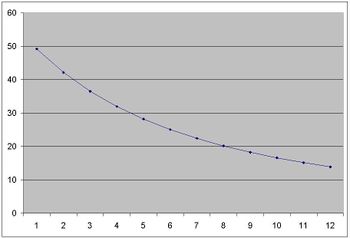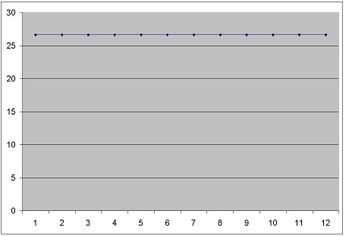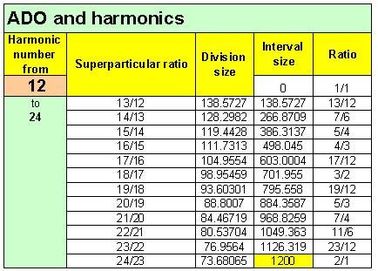AFDO
ADO (arithmetic divisions of the octave) is a tuning system which divides the octave arithmetically rather than logarithmically. For any C-ADO system, the m-th degree is equal to the ratio (C+m)/C. For example, in 12-ADO the first degree is 13/12, the second is 14/12 (7/6), and so on. For an ADO system, the distance between interval ratios is equal, rater than the distance between their logarithms like in EDO systems. ADOs with more divisors such as highly composite ADOs generally have more useful just intervals.
If the first division is [math]\displaystyle{ R_1 }[/math] (which is ratio of C/C) and the last , [math]\displaystyle{ R_n }[/math] (which is ratio of 2C/C), with common difference of d
(which is 1/C), we have :
[math]\displaystyle{ R_2 = R_1 + d \\ R_3= R_1 + 2d \\ R_4 = R_1 + 3d \\ \vdots \\ R_n = R_1 + (n-1)d }[/math]
If the first division has ratio of R1 and length of L1 and the last, Rn and Ln , we have: Ln = 1/Rn and if Rn >........> R3 > R2 > R1 so :
L1 > L2 > L3 > …… > Ln

This lengths are related to reverse of ratios in system.The above picture shows the differences between divisions of length in 12-ADO system . On the contrary , we have equal divisios of length in **EDL system**:


Relation between harmonics and ADO system
ADO (like EDL) is based on **Superparticular ratios** and **harmonic series**. Have a look at 12-ADO in this picture:

The above picture shows that ADO system is classified as :
- System with unequal **epimorios** (**Superparticular**) divisions.
- System based on ascending series of superparticular ratios with descending sizes.
- System which covers superparticular ratios between harmonic of number C (in this example 12)to harmonic of Number 2C(in this example 24).
- An spreadsheet showing relation between harmonics , superparticular ratios and ADO system
Relation between Otonality and ADO system
We can consider ADO system as **Otonal system** .Otonality is a term introduced by **Harry Partch** to describe chords whose notes are the overtones (multiples) of a given fixed tone.Considering ADO , an Otonality is a collection of pitches which can be expressed in ratios that have equal denominators. For example, 1/1, 5/4, and 3/2 form an Otonality because they can be written as 4/4, 5/4, 6/4. Every Otonality is therefore part of the **harmonic series**. nominator here is called "**Numerary nexus**".An Otonality corresponds to an **arithmetic series** of frequencies or a **harmonic series** of wavelengths or distances on a **string instrument**.
- Fret position calculator (excel sheet ) based on EDL system and string length
- How to approximate EDO and ADO systems with each other?Download this file
Related to ADO
**Magic of Tone and the Art of Music by the late Dane Rhudyar** OD, or otonal division: An n-ADO is equivalent to an n-ODO.